Kanji for High, Tall, Expensive: 高 (Taka-i)
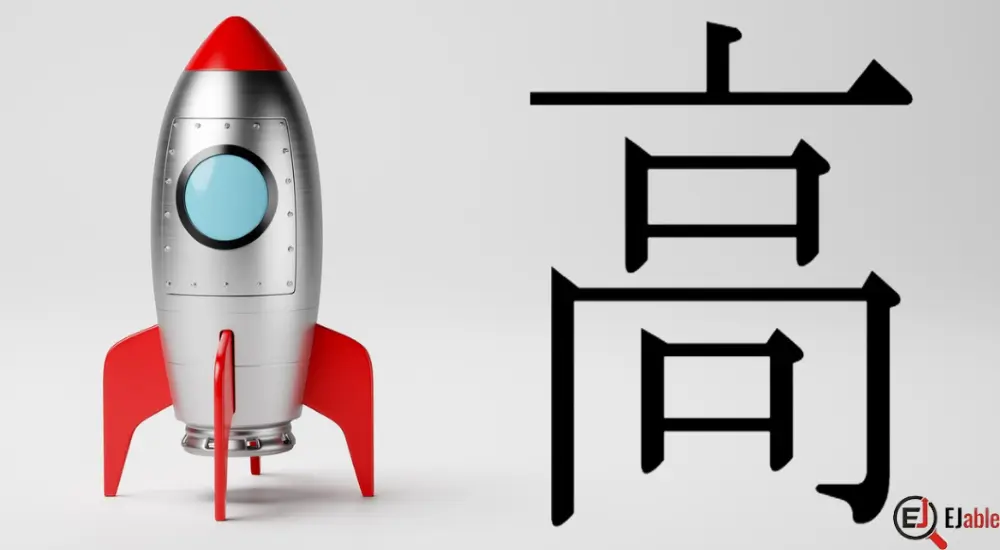
The Japanese kanji 高 means “High,” “Tall,” or “Expensive.”
The kun’yomi (Japanese reading) pronunciation of the Kanji 高 is “taka” (たか) as in the words taka-i (たか-い), taka-maru (たか-まる), and taka-meru (たか-める). The on’yomi (Chinese reading) pronunciation of 高 is “ko” (コウ).
The Kanji 高 for “tall” or “high” frequently appears in Japanese names, and in that case, it is pronounced as “ka” (か), “ko” (こ), “joi” (じょい), “ta” (た), or “haka” (はか).
Please note that while 高 means “high” or “tall” for physical aspects, its meaning as expensive in value is derived from the same concept of being higher in value.
The Kanji 高 is constructed with 10 strokes. It is part of the JLPT N5 syllabus (please check the JLPT N5 Kanji list). In Japanese schools, this Kanji is taught in grade 2.
Other Meanings of 高
- Expensive or High-Priced: Beyond representing physical elevation or height, 高 is also used to indicate a high price or cost, as in 高価 (こうか / kōka), meaning “expensive” or “high-priced.”
- High Grade or Superior: It can also refer to quality, suggesting something is of a high grade or superior, as in 高品質 (こうひんしつ / kōhinshitsu), meaning “high quality.”
- Senior or Advanced: In certain contexts, 高 can denote a level of seniority or advancement, as in 高年 (こうねん / kōnen), meaning “advanced age.”
Origin of the Shape 高
If we see the old shape of the Kanji 高 in the Oracle Bone Script, it depicts a tall arched gate with a watch tower above it and the kanji of mouth as a component below it.
Let’s see the evolution of the shape of the Kanji, meaning high, tall, or expensive, from ancient times to the current:
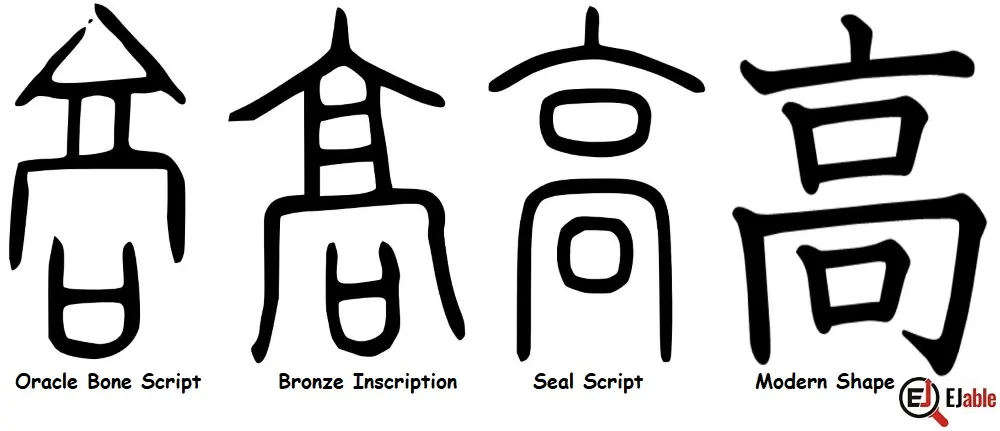

The above image shows the historical shape of 高 in Oracle Bone Script, Bronze inscription, small seal script, and how we write it in the present.
While the tall arched gate with a watch tower can abstractly represent tallness, this representation can not be considered concluding. Moreover, while this explanation is quite common, not much is said about the component of the mouth’s Kanji under the gate. Our explanation for this complete shape is as follows:
Explanation of the Origin of the Shape 高
Being tall, high, expensive, superior, senior, or advanced, i.e., all the qualities the Kanji 高 represents, has one common concept, and that is being superior or of higher stature than average. In other words, it is something people look up to.
If we go back to olden society, in any village or clan, the highest or most powerful person would be the leader or chief of that place. However, though the leaders change, one thing that remains common is where they live and from where they command. Consider it the leader’s den, palace, or fort.
Therefore, the tall arched gate with a watch tower can represent the leader’s den. The mouth component under the gate can represent the commanding voice of someone of high stature or a leader to whom people listen.
Mnemonic: How to Remember the Kanji for Tall or Expensive (高)
As mentioned above, it’s easy to understand the original shape of the Kanji 高. However, over time, this Kanji has evolved in such a way that it’s difficult to relate it to its original meaning and remember it. Considering the following illustration as a mnemonic can serve the purpose of relating 高 with tallness:
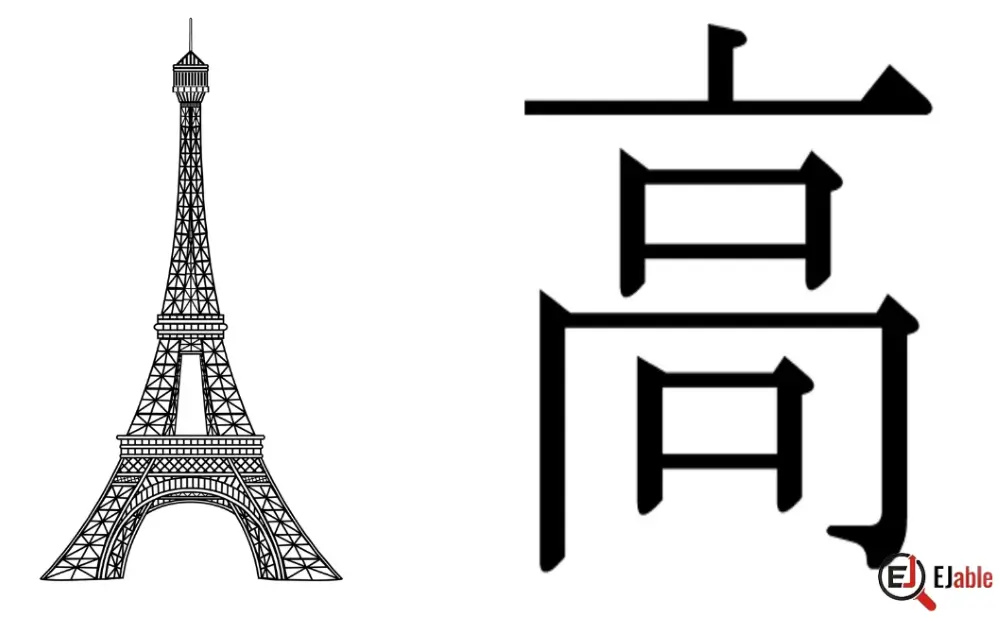

Stroke Order for the Kanji 高
The following illustrations show the order of the 10 strokes to write the Kanji 高 meaning tall of expensive:
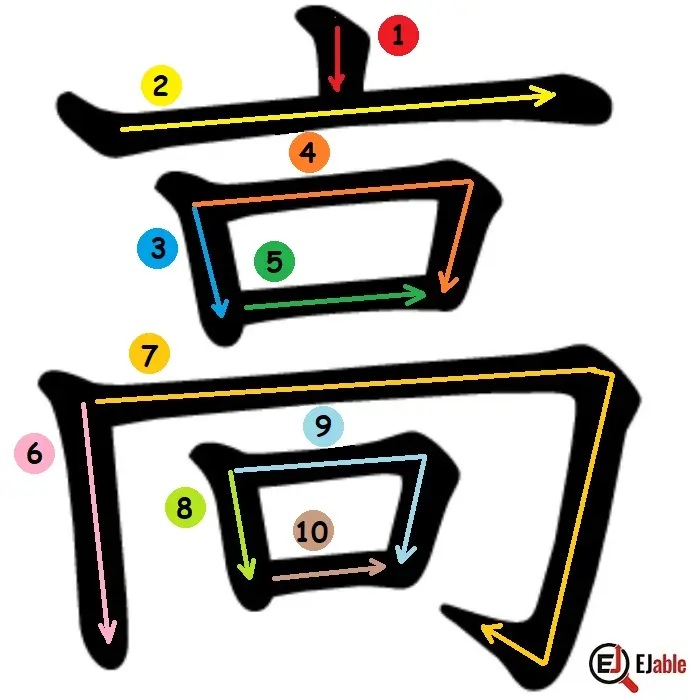

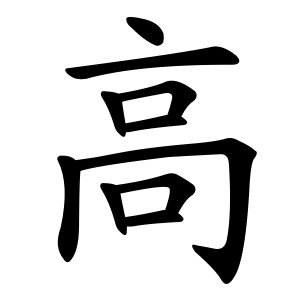

Kanji 高 in Compounded Words
The kanji 高 appears commonly in Japanese and forms part of many compound words. There are 526 Japanese words that begin with the Kanji 高, and it appears in 947 words. Moreover, the Kanji also appears in 6472 Japanese names.
Examples of Kanji 高 in Compounded Kanji Characters
Following are the examples where the Kanji 高 appears in Japanese compounded Kanji characters:
- 高校 (こうこう / kōkō): High school.
- 高価 (こうか / kōka): High-priced, expensive.
- 高速 (こうそく / kōsoku): High speed.
- 高度 (こうど / kōdo): Altitude; high degree.
- 高層 (こうそう / kōsō): High-rise, skyscraper.
- 高級 (こうきゅう / kōkyū): High class, high grade.
- 高原 (こうげん / kōgen): Plateau, highland.
- 高温 (こうおん / kōon): High temperature.
- 高齢 (こうれい / kōrei): Old age, advanced age.
- 高潮 (こうちょう / kōchō): High tide.
- 高等 (こうとう / kōtō): Advanced level, high rank.
- 高圧 (こうあつ / kōatsu): High pressure.
- 高血圧 (こうけつあつ / kōketsuatsu): High blood pressure.
- 高尚 (こうしょう / kōshō): Noble, high-minded.
- 高揚 (こうよう / kōyō): Elevation, uplifting (of spirits, etc.).
The above compound words express various concepts related to being higher or taller in physical height, level of quality, speed, and age, showcasing the significance of the Kanji 高 in defining tallness, expensiveness, or higher stature in the Japanese language.
高 as a Radical or Component
The Kanji 高 is not used as a radical and also does not appear as a component in other Kanji characters except in the Kanji 稿, meaning “draft” or “manuscript.”
The left part of the character is 禾 (pronounced “kome“), which is a radical representing grain or rice, and the right part is 高 (high).
This combination suggests the original meaning related to tall rice plants or grain, which over time extended metaphorically to represent manuscripts or drafts, possibly implying the cultivation of ideas or works until they reach maturity.
Note: Check other Kanji characters on the page “How to Remember Kanji“. You may also like to read about the common Kanji radicals.


A long-term ex-pat in Japan, Himanshu comes with an IT background in SAP consulting, IT Business Development, and then running the country operations of an IT consulting multinational. Himanshu is the co-founder and Managing Director of ReachExt K.K. and EJable.com. He is also an Advisory Board Member of a Silicon Valley AI/IoT startup.

